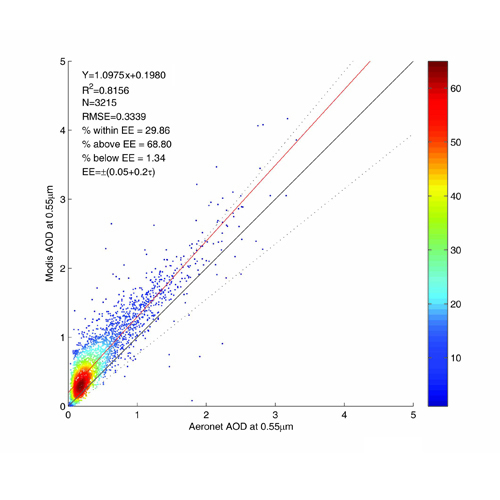Evaluation and Comparison of Long-Term MODIS C5.1 and C6 Products against AERONET Observations over China
Abstract
:1. Introduction
2. Materials and Methods
2.1. MODIS AOD Data
2.2. AERONET AOD Data
2.3. Spatial Matching Methods of MODIS and AERONET
2.4. Validation Methods
3. Results
3.1. Evaluations of MODIS C5.1 and C6 DT 10 km AOD products
3.2. Evaluations of MODIS C5.1 and C6 DB 10 km AOD Products
3.3. Inter-Comparison Between C5.1 and C6 AOD Products
3.4. Evaluation of the DT 3 km AOD Product
3.5. Regional Applicability for Different AOD Products Over China
4. Discussion
5. Conclusions
Acknowledgments
Author Contributions
Conflicts of Interest
References
- Ruiz-Arias, J.A.; Dudhia, J.; Gueymard, C.A.; Pozo-Vazquez, D. Assessment of the level-3 modis daily aerosol optical depth in the context of surface solar radiation and numerical weather modeling. Atmos. Chem. Phys. 2013, 13, 675–692. [Google Scholar] [CrossRef]
- Cui, X.; Wang, X.; Yang, L.; Chen, B.; Chen, J.; Andersson, A.; Gustafsson, O. Radiative absorption enhancement from coatings on black carbon aerosols. Sci. Total Environ. 2016, 551, 51–56. [Google Scholar] [CrossRef] [PubMed]
- Lu, X.C.; Lin, C.Q.; Li, Y.; Yao, T.; Fung, J.C.H.; Lau, A.K.H. Assessment of health burden caused by particulate matter in southern china using high-resolution satellite observation. Environ. Int. 2017, 98, 160–170. [Google Scholar] [CrossRef] [PubMed]
- Gopal, K.R.; Reddy, K.R.O.; Balakrishnaiah, G.; Arafath, S.M.D.; Reddy, N.S.K.; Rao, T.C.; Reddy, T.L.; Reddy, R.R. Regional trends of aerosol optical depth and their impact on cloud properties over southern india using modis data. J. Atmos. Sol. Terr. Phys. 2016, 146, 38–48. [Google Scholar] [CrossRef]
- Kan, H.; Chen, R.; Tong, S. Ambient air pollution, climate change, and population health in china. Environ. Int. 2012, 42, 10–19. [Google Scholar] [CrossRef] [PubMed]
- Che, H.; Xia, X.; Zhu, J.; Li, Z.; Dubovik, O.; Holben, B.; Goloub, P.; Chen, H.; Estelles, V.; Cuevas-Agullo, E.; et al. Column aerosol optical properties and aerosol radiative forcing during a serious haze-fog month over north china plain in 2013 based on ground-based sunphotometer measurements. Atmos. Chem. Phys. 2014, 14, 2125–2138. [Google Scholar] [CrossRef] [Green Version]
- Janssen, N.A.H.; Fischer, P.; Marra, M.; Ameling, C.; Cassee, F.R. Short-term effects of pm2.5, pm10 and pm2.5–10 on daily mortality in the netherlands. Sci. Total Environ. 2013, 463, 20–26. [Google Scholar] [CrossRef] [PubMed]
- Bergen, S.; Sheppard, L.; Sampson, P.D.; Kim, S.Y.; Richards, M.; Vedal, S.; Kaufman, J.D.; Szpiro, A.A. A national prediction model for pm2.5 component exposures and measurement error-corrected health effect inference. Environ. Health Perspect. 2013, 121, 1017–1025. [Google Scholar] [CrossRef] [PubMed]
- Matus, K.; Nam, K.-M.; Selin, N.E.; Lamsal, L.N.; Reilly, J.M.; Paltsev, S. Health damages from air pollution in china. Glob. Environ. Chang. 2012, 22, 55–66. [Google Scholar] [CrossRef]
- Hatzianastassiou, N.; Gkikas, A.; Mihalopoulos, N.; Torres, O.; Katsoulis, B.D. Natural versus anthropogenic aerosols in the eastern mediterranean basin derived from multiyear toms and modis satellite data. J. Geophys. Res. Atmos. 2009, 114. [Google Scholar] [CrossRef]
- Wong, M.S.; Shahzad, M.I.; Nichol, J.E.; Lee, K.H.; Chan, P.W. Validation of modis, misr, omi, and calipso aerosol optical thickness using ground-based sunphotometers in hong kong. Int. J. Remote Sens. 2013, 34, 897–918. [Google Scholar] [CrossRef]
- Guang, J.; Xue, Y.; Wang, Y.; Li, Y.J.; Mei, L.L.; Xu, H.; Liang, S.L.; Wang, J.D.; Bai, L.Y. Simultaneous determination of aerosol optical thickness and surface reflectance using aster visible to near-infrared data over land. Int. J. Remote Sens. 2011, 32, 6961–6974. [Google Scholar] [CrossRef]
- Hsu, N.C.; Gautam, R.; Sayer, A.M.; Bettenhausen, C.; Li, C.; Jeong, M.J.; Tsay, S.C.; Holben, B.N. Global and regional trends of aerosol optical depth over land and ocean using seawifs measurements from 1997 to 2010. Atmos. Chem. Phys. 2012, 12, 8037–8053. [Google Scholar] [CrossRef]
- Kang, N.; Kumar, K.R.; Hu, K.; Yu, X.N.; Yin, Y. Long-term (2002–2014) evolution and trend in collection 5.1 level-2 aerosol products derived from the modis and misr sensors over the chinese yangtze river delta. Atmos. Res. 2016, 181, 29–43. [Google Scholar] [CrossRef]
- Hauser, A.; Oesch, D.; Foppa, N. Aerosol optical depth over land: Comparing aeronet, avhrr and modis. Geophys. Res. Lett. 2005, 32. [Google Scholar] [CrossRef]
- Remer, L.A.; Kaufman, Y.J.; Tanre, D.; Mattoo, S.; Chu, D.A.; Martins, J.V.; Li, R.R.; Ichoku, C.; Levy, R.C.; Kleidman, R.G.; et al. The modis aerosol algorithm, products, and validation. J. Atmos. Sci. 2005, 62, 947–973. [Google Scholar] [CrossRef]
- Levy, R.C.; Remer, L.A.; Kleidman, R.G.; Mattoo, S.; Ichoku, C.; Kahn, R.; Eck, T.F. Global evaluation of the collection 5 modis dark-target aerosol products over land. Atmos. Chem. Phys. 2010, 10, 10399–10420. [Google Scholar] [CrossRef] [Green Version]
- Kaufman, Y.J.; Tanré, D.; Remer, L.A.; Vermote, E.F.; Chu, A.; Holben, B.N. Operational remote sensing of tropospheric aerosol over land from eos moderate resolution imaging spectroradiometer. J. Geophys. Res. Atmos. 1997, 102, 17051–17067. [Google Scholar] [CrossRef]
- Mao, K.B.; Ma, Y.; Xia, L.; Chen, W.Y.; Shen, X.Y.; He, T.J.; Xu, T.R. Global aerosol change in the last decade: An analysis based on modis data. Atmos. Environ. 2014, 94, 680–686. [Google Scholar] [CrossRef]
- Georgoulias, A.; Alexandri, G.; Kourtidis, K.; Lelieveld, J.; Zanis, P.; Amiridis, V. Differences between the modis collection 6 and 5.1 aerosol datasets over the greater mediterranean region. Atmos. Environ. 2016, 147, 310–319. [Google Scholar] [CrossRef]
- Hsu, N.C.; Tsay, S.C.; King, M.D.; Herman, J.R. Aerosol properties over bright-reflecting source regions. IEEE Trans. Geosci. Remote Sens. 2004, 42, 557–569. [Google Scholar] [CrossRef]
- Bilal, M.; Nichol, J.E.; Wang, L.C. New customized methods for improvement of the modis c6 dark target and deep blue merged aerosol product. Remote Sens. Environ. 2017, 197, 115–124. [Google Scholar] [CrossRef]
- Sayer, A.M.; Munchak, L.A.; Hsu, N.C.; Levy, R.C.; Bettenhausen, C.; Jeong, M.J. Modis collection 6 aerosol products: Comparison between aqua’s e-deep blue, dark target, and “merged” data sets, and usage recommendations. J. Geophys. Res. 2014, 119, 13965–13989. [Google Scholar] [CrossRef]
- Levy, R.C.; Mattoo, S.; Munchak, L.A.; Remer, L.A.; Sayer, A.M.; Patadia, F.; Hsu, N.C. The collection 6 modis aerosol products over land and ocean. Atmos. Meas. Tech. 2013, 6, 2989–3034. [Google Scholar] [CrossRef]
- Hsu, N.C.; Jeong, M.J.; Bettenhausen, C.; Sayer, A.M.; Hansell, R.; Seftor, C.S.; Huang, J.; Tsay, S.C. Enhanced deep blue aerosol retrieval algorithm: The second generation. J. Geophys. Res. Atmos. 2013, 118, 9296–9315. [Google Scholar] [CrossRef]
- Remer, L.A.; Mattoo, S.; Levy, R.C.; Munchak, L.A. Modis 3 km aerosol product: Algorithm and global perspective. Atmos. Meas. Tech. 2013, 6, 1829–1844. [Google Scholar] [CrossRef]
- De Leeuw, G.; Sogacheva, L.; Rodriguez, E.; Kourtidis, K.; Georgoulias, A.K.; Alexandri, G.; Amiridis, V.; Proestakis, E.; Marinou, E.; Xue, Y.; et al. Two decades of satellite observations of aod over mainland china. Atmos. Chem. Phys. Discuss. 2017, 2017, 1–33. [Google Scholar] [CrossRef]
- Che, H.; Zhang, X.Y.; Xia, X.; Goloub, P.; Holben, B.; Zhao, H.; Wang, Y.; Zhang, X.C.; Wang, H.; Blarel, L.; et al. Ground-based aerosol climatology of china: Aerosol optical depths from the china aerosol remote sensing network (carsnet) 2002–2013. Atmos. Chem. Phys. 2015, 15, 7619–7652. [Google Scholar] [CrossRef]
- Che, H.Z.; Zhang, X.Y.; Chen, H.B.; Damiri, B.; Goloub, P.; Li, Z.Q.; Zhang, X.C.; Wei, Y.; Zhou, H.G.; Dong, F.; et al. Instrument calibration and aerosol optical depth validation of the china aerosol remote sensing network. J. Geophys. Res. Atmos. 2009, 114. [Google Scholar] [CrossRef]
- Georgoulias, A.K.; Alexandri, G.; Kourtidis, K.A.; Lelieveld, J.; Zanis, P.; Poeschl, U.; Levy, R.; Amiridis, V.; Marinou, E.; Tsikerdekis, A. Spatiotemporal variability and contribution of different aerosol types to the aerosol optical depth over the eastern mediterranean. Atmos. Chem. Phys. 2016, 16, 13853–13884. [Google Scholar] [CrossRef]
- Sayer, A.M.; Hsu, N.C.; Bettenhausen, C.; Jeong, M.J.; Meister, G. Effect of modis terra radiometric calibration improvements on collection 6 deep blue aerosol products: Validation and terra/aqua consistency. J. Geophys. Res. Atmos. 2015, 120. [Google Scholar] [CrossRef]
- Saponaro, G.; Kolmonen, P.; Sogacheva, L.; Rodriguez, E.; Virtanen, T.; de Leeuw, G. Estimates of the aerosol indirect effect over the baltic sea region derived from 12 years of modis observations. Atmos. Chem. Phys. 2017, 17, 3133–3143. [Google Scholar] [CrossRef]
- Che, H.Z.; Wang, Y.Q.; Sun, J.Y.; Zhang, X.C.; Zhang, X.Y.; Guo, J.P. Variation of aerosol optical properties over the taklimakan desert in china. Aerosol Air Qual. Res. 2013, 13, 777–785. [Google Scholar] [CrossRef]
- Che, H.Z.; Wang, Y.Q.; Sun, J.Y. Aerosol optical properties at mt. Waliguan observatory, china. Atmos. Environ. 2011, 45, 6004–6009. [Google Scholar] [CrossRef]
- Cheng, F.; Zhang, J.H.; He, J.L.; Zha, Y.; Li, Q.N.; Li, Y.M. Analysis of aerosol-cloud-precipitation interactions based on modis data. Adv. Space Res. 2017, 59, 63–73. [Google Scholar] [CrossRef]
- Xie, Y.; Wang, Y.; Zhang, K.; Dong, W.; Lv, B.; Bai, Y. Daily estimation of ground-level pm2.5 concentrations over beijing using 3 km resolution modis aod. Environ. Sci. Technol 2015, 49, 12280–12288. [Google Scholar] [CrossRef] [PubMed]
- Zhang, Q.; Xin, J.Y.; Yin, Y.; Wang, L.L.; Wang, Y.S. The variations and trends of modis c5 & c6 products’ errors in the recent decade over the background and urban areas of north china. Remote Sens. 2016, 8, 754. [Google Scholar] [CrossRef]
- Bilal, M.; Nichol, J.E.; Nazeer, M. Validation of aqua-modis c051 and c006 operational aerosol products using aeronet measurements over pakistan. IEEE J. Sel. Top. Appl. Earth Obs. Remote Sens. 2016, 9, 2074–2080. [Google Scholar] [CrossRef]
- Tao, M.; Chen, L.; Wang, Z.; Tao, J.; Che, H.; Wang, X.; Wang, Y. Comparison and evaluation of the modis collection 6 aerosol data in china. J. Geophys. Res. Atmos. 2015, 120, 6992–7005. [Google Scholar] [CrossRef]
- Nichol, J.E.; Bilal, M. Validation of modis 3 km resolution aerosol optical depth retrievals over asia. Remote Sens. 2016, 8, 328. [Google Scholar] [CrossRef]
- He, Q.Q.; Zhang, M.; Huang, B.; Tong, X.L. Modis 3 km and 10 km aerosol optical depth for china: Evaluation and comparison. Atmos. Environ. 2017, 153, 150–162. [Google Scholar] [CrossRef]
- Xiao, Q.; Zhang, H.; Choi, M.; Li, S.; Kondragunta, S.; Kim, J.; Holben, B.; Levy, R.C.; Liu, Y. Evaluation of viirs, goci, and modis collection 6 aod retrievals against ground sunphotometer observations over east asia. Atmos. Chem. Phys. 2016, 16, 1255–1269. [Google Scholar] [CrossRef]
- Sayer, A.M.; Hsu, N.C.; Bettenhausen, C.; Jeong, M.J. Validation and uncertainty estimates for modis collection 6 “deep blue” aerosol data. J. Geophys. Res. Atmos. 2013, 118, 7864–7872. [Google Scholar] [CrossRef]
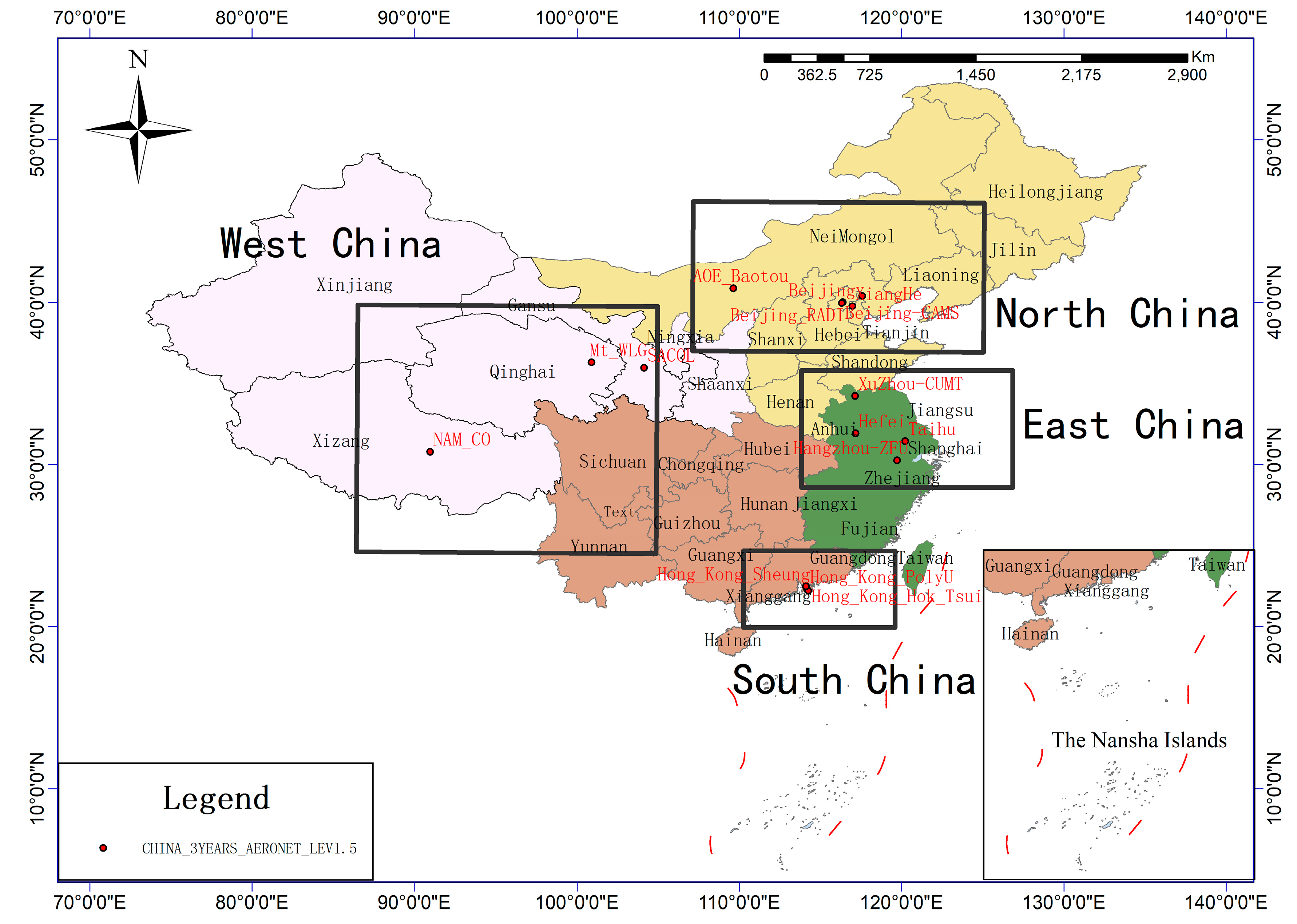
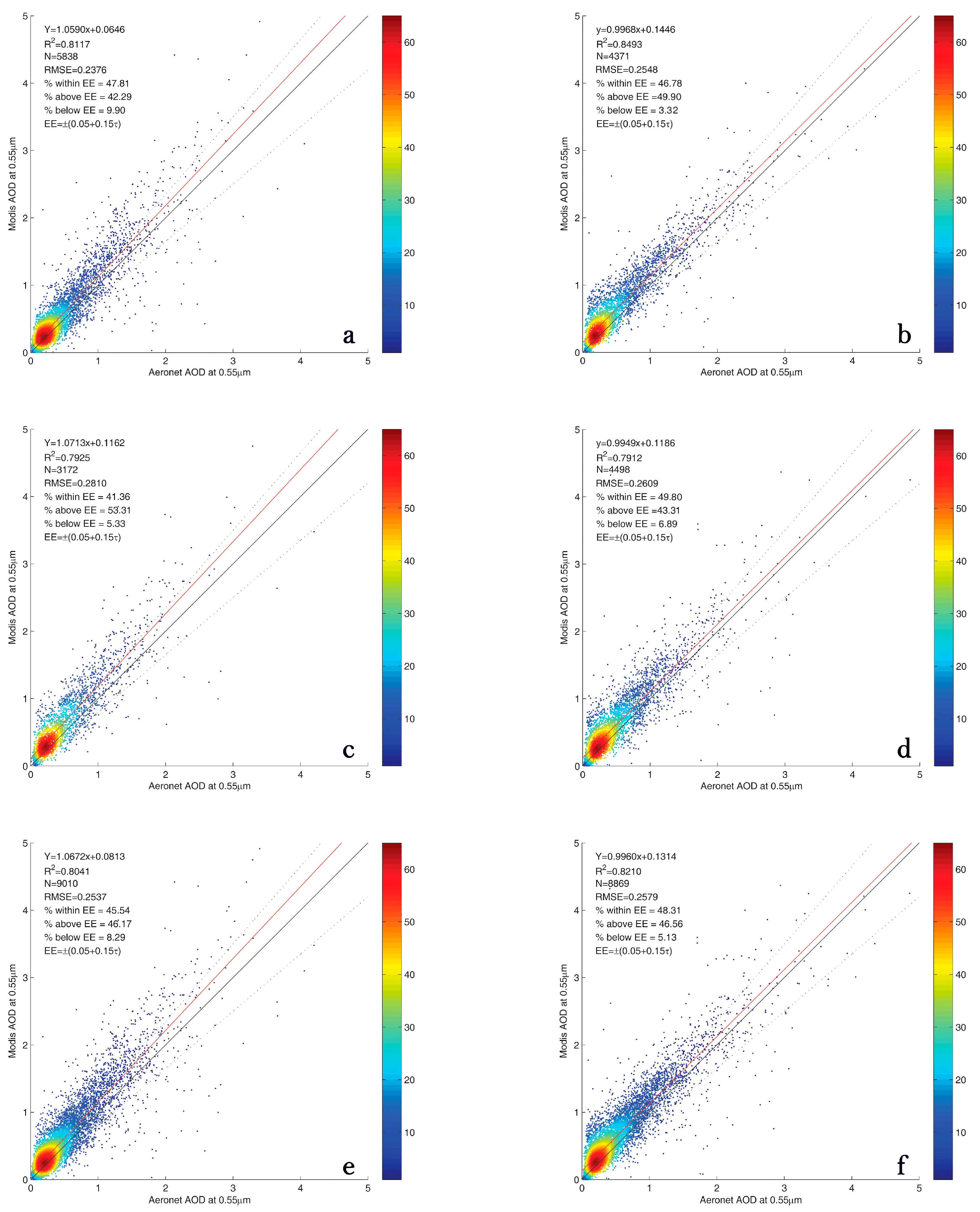

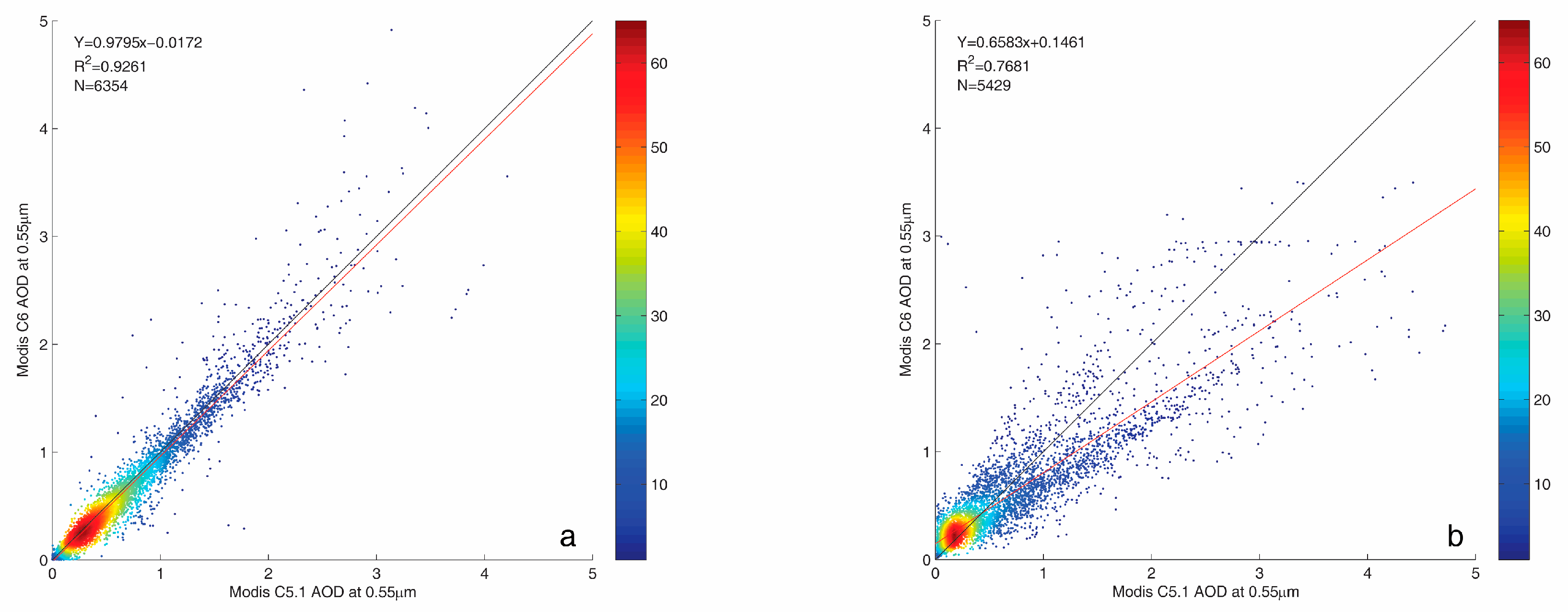
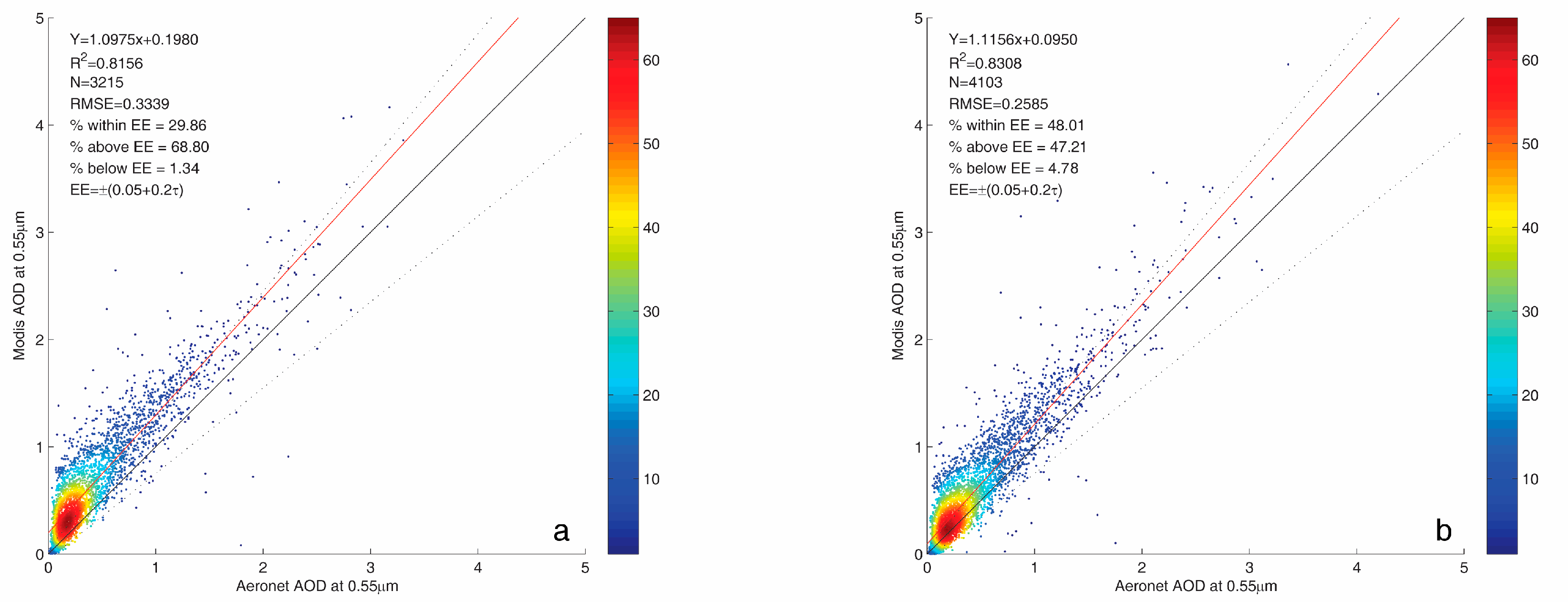
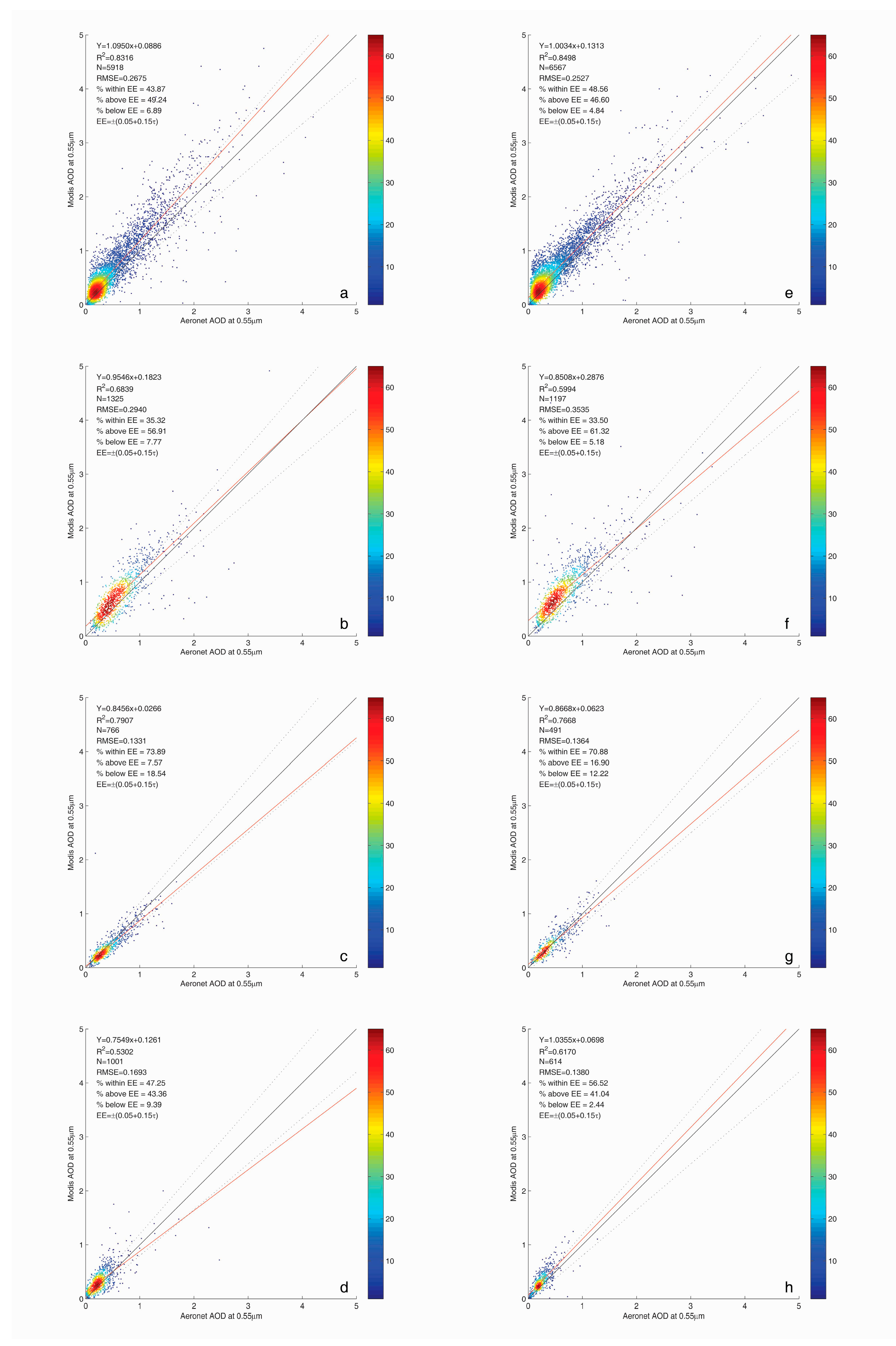
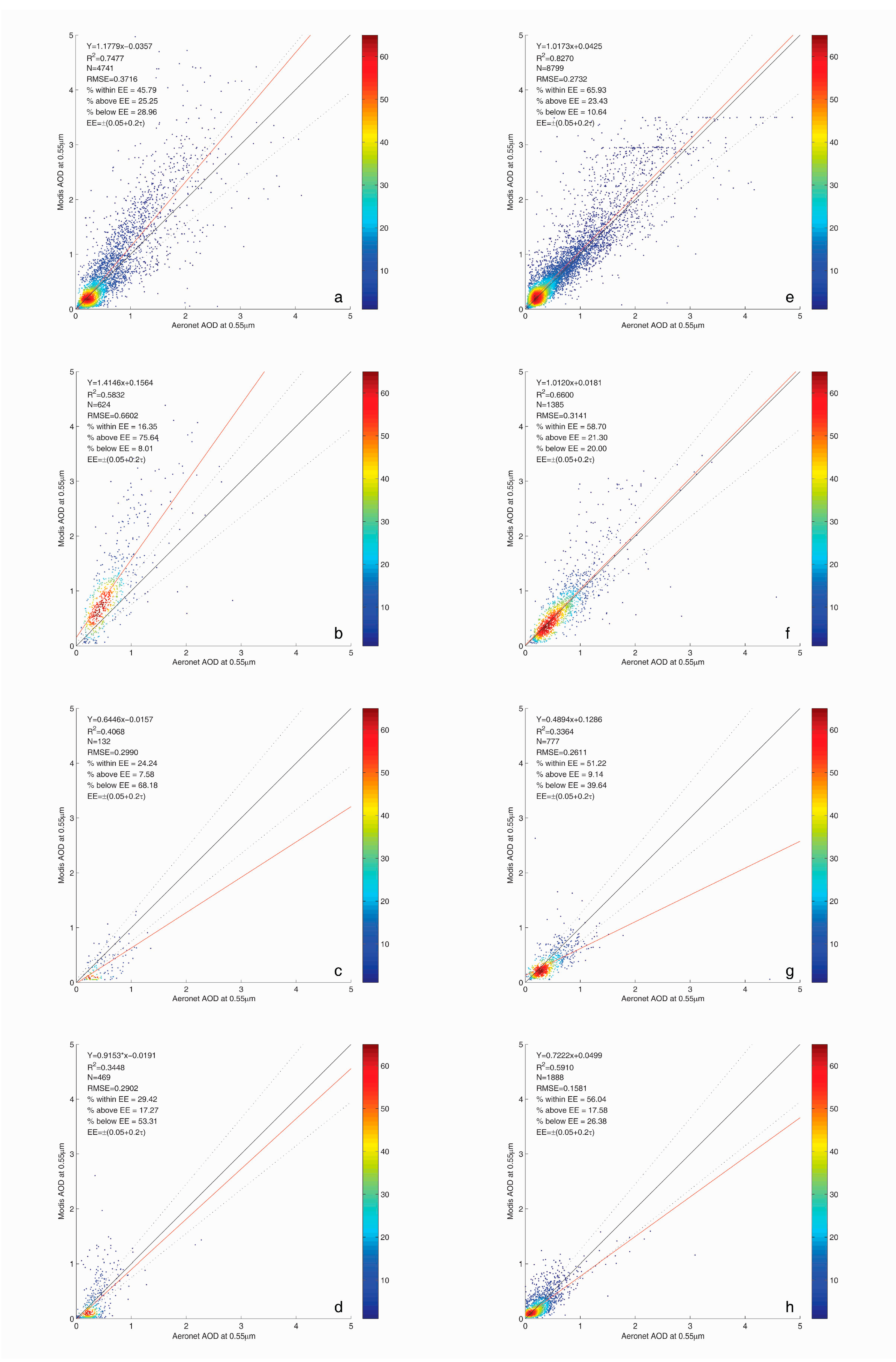
| Terra C5.1 | Terra C6 | Aqua C5.1 | Aqua C6 | Combined C5.1 | Combined C6 | |
|---|---|---|---|---|---|---|
| Slope | 1.0590 | 0.9968 | 1.0713 | 0.9949 | 1.0672 | 0.9960 |
| Intercept | 0.0646 | 0.1446 | 0.1162 | 0.1186 | 0.0813 | 0.1314 |
| R2 | 0.8117 | 0.8493 | 0.7925 | 0.7912 | 0.8041 | 0.8210 |
| N | 5838 | 4371 | 3172 | 4498 | 9010 | 8869 |
| RMSE | 0.2376 | 0.2548 | 0.2810 | 0.2609 | 0.2537 | 0.2579 |
| Within EE | 47.81% | 46.78% | 41.36% | 49.80% | 45.54% | 48.31% |
| Above EE | 42.29% | 49.90% | 53.31% | 43.31% | 46.17% | 46.56% |
| Below EE | 9.90% | 3.32% | 5.33% | 6.89% | 8.29% | 5.13% |
| Terra C5.1 | Terra C6 | Aqua C5.1 | Aqua C6 | Combined C5.1 | Combined C6 | |
|---|---|---|---|---|---|---|
| Slope | 1.1421 | 0.9588 | 1.2457 | 1.0225 | 1.2097 | 1.0068 |
| Intercept | −0.0101 | 0.0370 | 0.0357 | 0.0238 | −0.0268 | 0.0273 |
| R2 | 0.7062 | 0.8383 | 0.7087 | 0.7934 | 0.7065 | 0.8020 |
| N | 1867 | 2282 | 4099 | 10567 | 5966 | 12849 |
| RMSE | 0.3889 | 0.2508 | 0.4120 | 0.2664 | 0.4049 | 0.2637 |
| Within EE | 41.72% | 66.70% | 40.60% | 61.97% | 40.95% | 62.81% |
| Above EE | 28.34% | 18.62% | 30.03% | 22.10% | 29.50% | 21.48% |
| Below EE | 29.94% | 14.68% | 29.37% | 15.94% | 29.55% | 15.71% |
| Terra C6 | Aqua C6 | |
|---|---|---|
| Slope | 1.0975 | 1.1156 |
| Intercept | 0.1980 | 0.0950 |
| R2 | 0.8156 | 0.8308 |
| N | 3215 | 4103 |
| RMSE | 0.3339 | 0.2585 |
| Within EE | 29.86% | 48.01% |
| Above EE | 68.80% | 47.21% |
| Below EE | 1.34% | 4.78% |
| C5.1 North China | C5.1 East China | C5.1 South China | C5.1 West China | C6 North China | C6 East China | C6 South China | C6 West China | |
|---|---|---|---|---|---|---|---|---|
| Slope | 1.0950 | 0.9546 | 0.8456 | 0.7549 | 1.0034 | 0.8508 | 0.8668 | 1.0355 |
| Intercept | 0.0886 | 0.1823 | 0.0266 | 0.1261 | 0.1313 | 0.2876 | 0.0623 | 0.0698 |
| R2 | 0.8316 | 0.6839 | 0.7907 | 0.5302 | 0.8498 | 0.5994 | 0.7668 | 0.6170 |
| N | 5918 | 1325 | 766 | 1001 | 6567 | 1197 | 491 | 614 |
| RMSE | 0.2675 | 0.2940 | 0.1331 | 0.1693 | 0.2527 | 0.3535 | 0.1364 | 0.1380 |
| Within EE | 43.87% | 35.32% | 73.89% | 47.25% | 48.56% | 33.50% | 70.88% | 56.52% |
| Above EE | 49.24% | 56.91% | 7.57% | 43.36% | 46.60% | 61.32% | 16.90% | 41.02% |
| Below EE | 6.89% | 7.77% | 18.54% | 9.39% | 4.84% | 5.18% | 12.22% | 2.44% |
| C5.1 North China | C5.1 East China | C5.1 South China | C5.1 West China | C6 North China | C6 East China | C6 South China | C6 West China | |
|---|---|---|---|---|---|---|---|---|
| Slope | 1.1779 | 1.4146 | 0.6446 | 0.9153 | 1.0173 | 1.0120 | 0.4894 | 0.7222 |
| Intercept | −0.0357 | 0.1564 | −0.0157 | −0.0191 | 0.0425 | 0.0181 | 0.1286 | 0.0499 |
| R2 | 0.7477 | 0.5832 | 0.4068 | 0.3448 | 0.8270 | 0.6600 | 0.3364 | 0.5910 |
| N | 4741 | 624 | 132 | 469 | 8799 | 1385 | 777 | 1888 |
| RMSE | 0.3716 | 0.6602 | 0.2990 | 0.2902 | 0.2732 | 0.3141 | 0.2611 | 0.1581 |
| Within EE | 45.79% | 16.35% | 24.24% | 29.42% | 65.93% | 58.70% | 51.22% | 56.04% |
| Above EE | 25.25% | 75.64% | 7.58% | 17.27% | 23.43% | 21.30% | 9.14% | 17.58% |
| Below EE | 28.96% | 8.01% | 68.18% | 53.31% | 10.64% | 20.00% | 39.64% | 26.38% |
© 2017 by the authors. Licensee MDPI, Basel, Switzerland. This article is an open access article distributed under the terms and conditions of the Creative Commons Attribution (CC BY) license (http://creativecommons.org/licenses/by/4.0/).
Share and Cite
Fan, A.; Chen, W.; Liang, L.; Sun, W.; Lin, Y.; Che, H.; Zhao, X. Evaluation and Comparison of Long-Term MODIS C5.1 and C6 Products against AERONET Observations over China. Remote Sens. 2017, 9, 1269. https://doi.org/10.3390/rs9121269
Fan A, Chen W, Liang L, Sun W, Lin Y, Che H, Zhao X. Evaluation and Comparison of Long-Term MODIS C5.1 and C6 Products against AERONET Observations over China. Remote Sensing. 2017; 9(12):1269. https://doi.org/10.3390/rs9121269
Chicago/Turabian StyleFan, Aiping, Wei Chen, Long Liang, Wenbin Sun, Yi Lin, Huizheng Che, and Xuesheng Zhao. 2017. "Evaluation and Comparison of Long-Term MODIS C5.1 and C6 Products against AERONET Observations over China" Remote Sensing 9, no. 12: 1269. https://doi.org/10.3390/rs9121269




